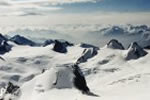


 |
 |
 |
The intense erosive action of a glacier produces vast volumes of sediments. Very fine material, called rock flour, is produced by the scraping and grinding or rock surfaces, whilst larger particles are produced by plucking and freeze-thaw. Massive rocks that fell from the valley walls onto the moving ice can also be transported, and then deposited hundreds of miles from their origins.
Geographers classify glacial sediment according to it's mode of deposition. The collective name for all the sediments and debris deposited under glacial conditions is Glacial Drift. Sediments that were deposited by melting ice or by glacial streams are called Fluvio-glacial. Debris deposited directly by the glacier, such as moraine and intra-glacial material dropped 'in situ' by retreating ice, is known as Till
The range of sediment sizes and processes of deposition produce a wide range of landforms.
We have pages about the following landforms:
Braided
Streams
Drumlins
Erratics
Eskers
Kames
and Kettles
Moraine
Outwash
Plain
Rock
Flour
Varves
We value
your ideas and suggestions. Please contact the
maintainer of this site.
This page
can be found at: http://www.geography-site.co.uk
Last update to
this statement was on:
February 23, 2006
© Copyright Geography Site